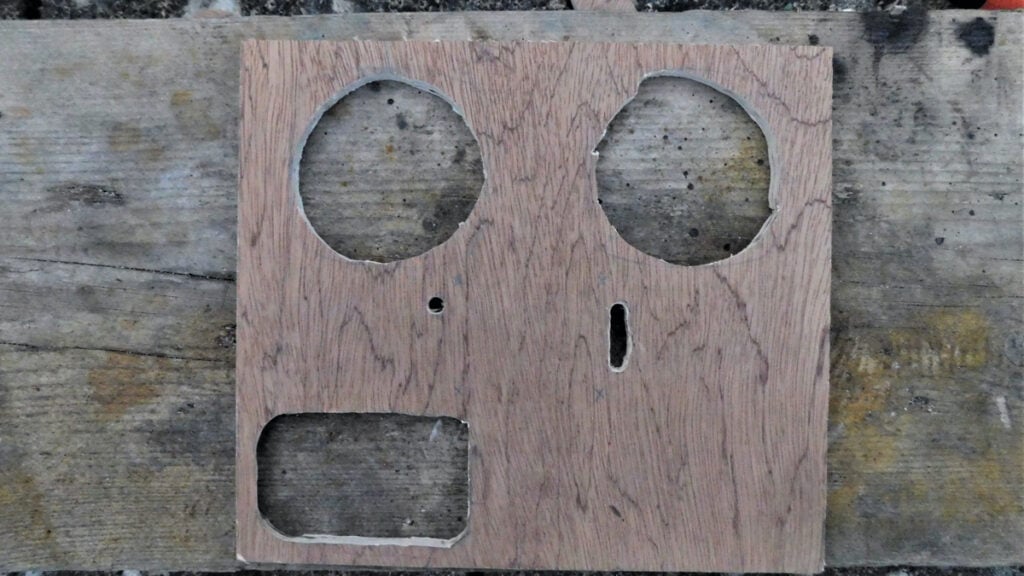
A little while ago, I bought a cigarette lighter-powered DAB radio for my car, but due to the position of the handbrake, couldn’t actually fit it, so that got me wondering. I’ve been investigating building a DAB radio into a pair of vintage speakers for a while, but it’s surprisingly hard to find a hackable DAB module at a reasonable price. Rather than seeking out a module, why not pull this radio to pieces and see what I can make out of it? I’d already attempted to fit it, so I couldn’t return it anyway.
Unlike a WiFi speaker, this one will need a user interface, so it’s going to require cutting holes in the speakers. Before I took the saw to the vintage speakers, I decided to make a prototype using a few bits I had sitting around for another project (a pair of speakers and an amp that will hopefully one day become part of a synth).
The unit has a leg that should slot into a car cigarette lighter port, then a body with an LCD screen, a scroll-wheel, and four buttons. Surely it’s possible to take the leg off and mount the screen on another panel? With my screwdriver, I set to work finding out.
With the back of the case removed, I noticed that the power connection was soldered onto the footprint of a USB connector. Car cigarette lighters give out 12 V, so this seemed a bit odd. On closer inspection, there was a 12 V to 5 V conversion circuit in the leg. This was obviously designed to be something else before it became a car radio. Fortunately, I noticed this before pushing 12 V into the unit.

I wanted to create a prototype to make sure everything worked, but I also wanted it to be usable because an important part of the prototype process is making sure it fits in with your usage. There’s no point hacking apart the vintage speakers if it turns out I don’t really listen to DAB and just use the Bluetooth.
I had a square of spare 9 mm plywood, so I used this to make a panel. Designing an acoustically efficient speaker enclosure is a complex process, but I decided to sidestep it entirely and simply not have a back to the panel. This compromises the audio quality, but not enough for me to worry about for a prototype.
The task of building the prototype was then just to cut out appropriately sized holes in the panel, mount everything, and wire it all up: nothing a drill, jigsaw, and Dremel particularly struggled with. I’ve always liked the idea of exposed electronics on things, so decided to mount the amp circuit board on the front and show it off. Again, this was another little experiment to see if I liked living with exposed electronics.

As it was just a prototype, I didn’t put in quite as much design work as I should have, and there are a few flaws – the aerial cable goes under the bottom of the panel, and this means it doesn’t sit flat, and the audio input hole is too close to the amp. They’re all things I can live with for a prototype, but ones I’d change if it were a permanent design. Note to self: think more about cable routing in the future.
Since the amp needed 12 V and the radio needed 5 V, I decided to power the system with 12 V and use a step-down converter to get 5 V for the radio (I would have mounted this like the amp, but I didn’t realise that I needed 5 V until after I’d created the panel, so this went on the back).
The major problem with using a repurposed car radio is that it wasn’t designed to be panel mounted, so there are no mounting holes. Since this is a temporary build, I didn’t want to do anything permanent to either the PCB or enclosure, so went straight for the hacker’s best friend: hot glue. While the speakers and amp are held with screws, everything else is kept in place with hot glue. If I progress on this build, I’ll do something a bit more secure – possibly 3D-print a bracket to hold it in place, or use a bit of epoxy to stick it on permanently.

With everything hooked up, I powered it up and tested it out. The DAB to amp to speakers all worked flawlessly (although the amp is a little overpowered for the speakers, so you have to be a bit careful with the volume knob). Press the scroll button and the DAB radio turns off, turning it into a Bluetooth speaker. My phone (a Moto G7) has a bug in the Bluetooth audio system, such that even the maximum audio over Bluetooth is really quiet, so having an overpowered amp makes this usable as a Bluetooth speaker for me.
Overall, I’m pleased with the repurposed car radio as an audio source. It has an intuitive interface, works well, and the audio line-out jack is easy to use with other audio systems. I’ll keep it running like this while I think of the best way to mount it on my vintage speakers.





